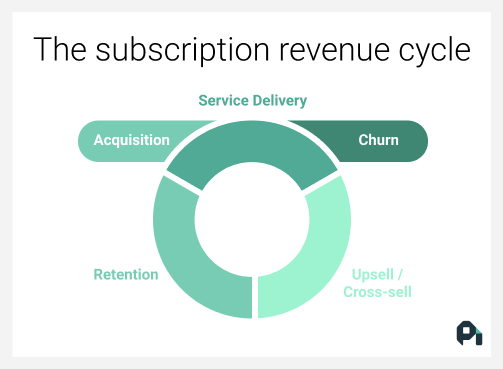In this day and age, subscriptions in the retail and consumer realm are standard in the form of curated boxes or repeat orders — from beauty boxes (Birchbox) and streaming services (Netflix) to meal delivery kits (HelloFresh) and designer clothing for rent (Rent The Runway).
Your mobile data plan is perhaps the most common type of subscription. You can set up an automated, recurring payment on your credit card to pay the phone bill or subscribe to any of the services (or more) described above. There is literally no dearth of B2C subscriptions.
On the business front, subscriptions for B2B software and products continue to grow rapidly. A Recurly study shows that trial subscriptions for business and professional services rose by 115% in May 2020. The buck does not stop here.
Interestingly, the subscription revenues have continued to grow 5X faster than S&P 500 industry benchmarks in the last decade. No wonder the market for SaaS, PaaS, and IaaS solutions is forecasted to be worth $344.3 billion by 2024.
In this blog post, we will study everything there is to know about B2B subscription management, starting with its definition.

What is B2B subscription management?
In simple words, it refers to the process of overseeing and controlling all aspects of the subscription process, including pricing, billing, inventory, delivery, contract renewals, and revenue reporting using a B2B subscription management software solution.
Managing B2B subscriptions ensures every customer receives the right product or service on time — monthly, quarterly, or yearly — and is invoiced the correct amount.
Why are B2B subscriptions necessary?
A Bain research shows that acquiring a new customer is anywhere from 5X-25X more expensive than retaining an existing one. What is better than following a subscription-based business model to secure a long-term supply of incoming revenue? Here are its top benefits:
- When your customer base signs up for your subscription services, they are implied to repeat business with you, which means a consistent source of recurring income for you.
- You do not need to remarket in great detail to your customers continually, allowing you to minimize your retention spending and focus on other critical matters.
- With a subscription-based business model, you can predict your revenue stream accurately and reliably and enjoy a firmer hold of your economic forecast — even if customer subscription cancellations happen (which are inevitable).
- Managing inventory for B2B brick-and-mortar firms becomes easier. Serve a construction company constantly needing cement, for instance? Offer subscriptions to products that run out or wear out faster, leveraging order fulfillment technology.
- Sell your most complex product or services on a recurring basis with payments spread over a period of time and lower the barrier to purchase.
- Fulfill modern customer expectations by offering a more open, self-service buying process that does not require the assistance of a sales rep.
Four Common B2B subscription models
As a growing number of B2B companies are exploring to diversify their revenue streams to include not only conventional transactional sales but also subscription offerings, here are the top B2B subscription models you can get inspired from:
1. Premium access or service model
This model typically begins with a free subscription that includes basic functionality that customers can later upgrade to for unlocking premium paid features. Grammarly, for instance, allows its customer base to access limited features for free forever.
2. Product-based subscriptions
As the name suggests, B2B companies charge monthly or annual fees in exchange for the use of products. For instance, many companies pay for accessing office furniture or electronics repeatedly. The Dutch book publishing company, Mendo, offers a subscription service to hotels, shops, and other commercial properties to expand their book collection.
3. Usage-based B2B subscriptions
In this model, customers use a product or service and bill you accordingly regularly. Examples include email marketing tools (Mailchimp and SendGrid) and data storage solutions (Dropbox) that bill their customers based on usage.
4. Service-based subscriptions
This model offers product support or accessory benefits on a recurring basis, either included with the purchase of a product in the guise of a warranty or provided as an upgrade by the sales rep. For instance, autoship subscriptions offer customers a regular supply of the same products used consistently, such as coffee pods or printer cartridges.
Five tips to get started with subscription-based selling
Pursuing subscription models requires a fundamental re-evaluation of how you want your business to interact with the customers, along with how you bill and record revenues. You need new processes and systems to implement the “experience-first” way of serving customers. We have crafted five guiding principles to help B2B companies address this transformation:
1. Orient everything around the customer
There is no point in providing subscriptions if you cannot create a compelling offering that solves a customer problem. Think through their overall buying journey to identify how you can further add value to your customer base. What do they really want?
Examples of B2B subscriptions include pay-per-click data searches, continuous-replenishment inventory models, and financial data subscriptions.
Create a list of products or services you can easily offer via subscriptions without hampering your business operations. You could, for instance, start with subscription-based warranties and then go on to advertising product upgrades and accessory subscriptions.
Regardless of what you choose based on the nature of your business, it should be of value to your target customer base.
2. Get all departments involved in strategy building
Do a revenue modeling exercise to reflect different price points, payment terms, subscription periods, and sales compensation. Dig into your company’s current revenue reporting to understand what you would have to change if you start offering subscriptions.
Your finance team may need special training for managing subscription-based accounting and reporting. Also include your sales and HR teams for understanding the implications of incentive compensation, quotas, and territories if your subscriptions rely on the strength of field sales.
Consider the skills your sales reps will need to build and maintain strong and long-lasting customer relationships. If you want the subscription model to work, you have to get all divisions working towards it under the same roof.
3. Revisit the foundational architecture
When you dip your toes into the subscription-based business model, you must test new ideas and accelerate time to market by leveraging platforms and capabilities.
Please ensure that your B2B subscription product offerings are resilient by deploying highly scalable architectures and processes that can evolve over a period to support changing customer needs.
Use platforms, managed services, applications, and other non-core components of your business to create a wholesome architecture.
4. Analyze your supply chain
Many B2B companies focus on product or service characteristics and the promise of customization. However, they often lack a 36-degree view of customer interaction along the value supply chain. So, what is the best way to tackle that?
Offer best-in-class delivery at a competitive cost that has traditionally been the winning combination of B2B organizations and industrial manufacturers for outranking competitors.
If you are in a similar business, you must ensure accurate, on-time fulfillment and delivery. Before starting your subscription business, take the time to audit every stage of your supply chain process.
Speak to manufacturers, logistics providers, parts suppliers, and warehouse managers. Consider their performance on key metrics to understand whether they can provide an ongoing service to multiple customers.
If there are recurring issues with order fulfillment, quality assurance, safety precautions, and more, you need to weed them out before you start offering subscriptions to your customers. This would be beneficial for you in the long run.
5. Measure the right customer metrics
Your subscription management strategy should have clear key performance indicators (KPIs) for measuring progress. Some examples include:
- Monthly Recurring Revenue (MRR) to calculate the monthly revenue for a subscription.
- Churn rate to review the number or percentage of customers who have terminated the subscription in a specific time period.
- Annual Recurring Revenue (ARR) to figure out the yearly revenue of a subscription. This metric helps see year-over-year trends and set growth goals.
- Renewal rate for calculating the total number of subscriptions renewed in a given period, divided by the total number of subscriptions due for renewal in that period.
The metrics, as mentioned above, will help you tweak and tune your subscription model to make it more profitable in the long run. The numbers allow you to make deliberate decisions about what to do and what not to do with your subscriptions.
Over to you
As modern B2B customers seem to shape-shift from one moment to the next, it is essential to keep up with their expectations. Subscriptions help you advance your expertise and craft foundational strategies in less time so you can fuel your continuous pursuit of customer experiences and hit the bull’s eye every time.
A B2B subscription model does not only bring value to your customers but also helps you build resilience for your overall business. You should be open to adapting to the current market scenario and customer needs to build an efficient subscription system that lasts. Good luck!


